LumoPro LP180 Quad-Sync Manual flash replaces the company's popular LP160 speedlight that was recently discontinued. The arrival of LP180 was much anticipated by many photographers, and the flash does not disappoint (especially considering the $199 price tag). LumoPro LP180 is loaded with innovation. In fact, it has two features that we have never seen in a speedlight before. So, we want to start the review by jumping right to those new features.
One of the coolest things of the LumoPro LP180 flash is a standard 1/4-20 mount built into the right side of the flash head. This allows you to screw the flash directly on a light stand, umbrella swivel adapter, tripod, etc. We are sure that many photographers will greatly appreciate this. (The right image below shows LP180 mounted on a Nasty Clamp.)
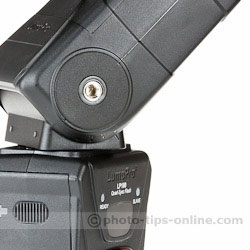 |
 |
A built-in light stand mount is a truly innovative thing, brilliant in its simplicity. Indeed, when used with an umbrella swivel adapter, the flash is positioned close to the axis, so it fires into the middle of the umbrella for more even lighting. There is a number of speedlight brackets out there that allow you to position your flash in a similar way using a cold shoe. LumoPro has elegantly solved this problem by simply embedding the mounting thread, so there is no need for a bracket.
The following images show how the light hits a 43" (109 cm) umbrella when LP180 (set to 14 mm zoom) mounted via a cold shoe (left) and directly via the built-in mount (right). As you can see in the right image, the light almost hits the center of the umbrella.
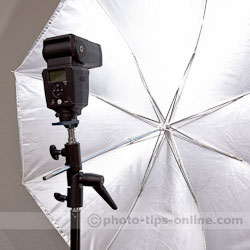 |
 |
The second feature that is unique to the LumoPro LP180 flash is the built-in gel holder. Sure, some Nikon and Canon flashes come with clip-on gels and gel holders, but the LumoPro flash head simply has a slot that takes the filters. Better yet, the flash comes with 22 gels: 11 for color effects and 11 for color correction. They are similar to Rosco filters but wider. So, when you insert them in the slot, they bow away to avoid potential gel melting.
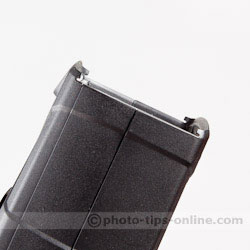 |
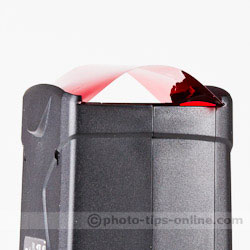 |
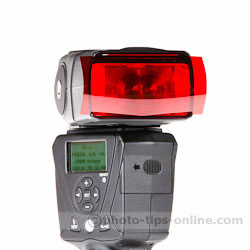 |
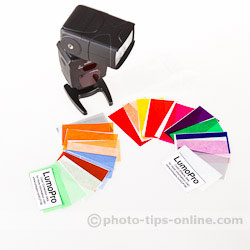 |
While initially we were very excited about the gel holder, we found a few drawbacks. First of all, it can be a bit tedious to install the gels. To be fair, however, after a couple of days of using them, we got a hang of it, and the installation became effortless for the most part. Another thing to keep in mind is that if you accidentally touch the filter when moving your flash, it may fly away because it is not really attached to the flash. For the same reason, use with light modifiers can be limited, even if you trim the gels to the width of the flash head.
Standard size gels also fit the LP180's fliter slot, but they tend to slip out, and they are very likely to melt if you fire at full power a few times.
The way we see it is that the included gels can be very handy as a quick solution when the flash is mounted on a stand, and you don't move it much. And hey, it's free :)!! Obviously, you can always use Honl Photo Gels, Rogue Filters, or any other speedlight gel system.
Now, let's get back to the basics. The first thing that struck us when we opened the box was the new contemporary design of LumoPro LP180. We found it very appealing. The flash is very well-built, and it feels very solid.
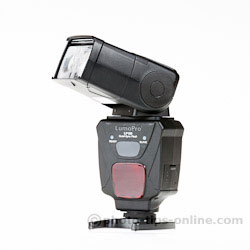 |
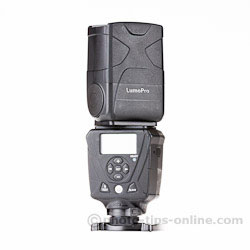 |
 |
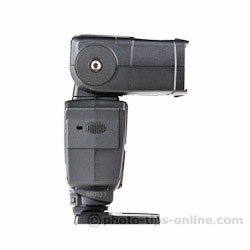 |
LP180 is a big flash. It is slightly bigger and heavier than Canon 580EX II (15oz/425g vs. 14.3oz/406g). However, since this flash is likely to be used off-camera by the majority of photographers, the weight does not really matter that much. Typically, we like the heftiness in our speedlights, so it is kind if a plus in our book ;).
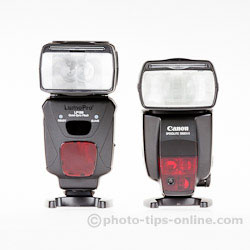 |
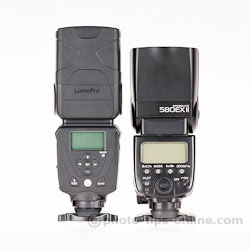 |
Amount of light a flash can deliver is one of the key characteristics that photographers are typically looking at. Most companies have their own way of specifying the Guide Number, the measure of the flash power. LumoPro specifies that LP180 has a GN of 110 (at 105 mm, ISO 100). The company also says that this is equivalent to the flagship units of other brands. Armed with a Sekonic light meter, we measured the light output of the LumoPro LP180 and Canon Speedlight 600EX-RT. The results were very impressive: LP180 and Canon's top-of-the-line unit performed virtually identically throughout the flash zoom range.
The power of LP180 can be adjusted in 1/3-stop, which is more or less industry standard these days, so it's great to see LumoPro keeping up with the market.
Recycling speed is another key factor of a flash performance. Once again, LumoPro LP180 shined in our tests: with a freshly charged set of Eneloop NiMH batteries, the average recycling time was just 2.6 seconds, which is exactly what we measured off of the Canon unit, as well.
It's common for speedlights to overheat when fired at full power in rapid successions (See, for example, our Nikon overheating test). LumoPro LP180 features a thermal cut-off function that increases the intervals between flash fires. In our tests at a room temperature, we could get 22 full-power pops at 2.6 second interval, after which the intervals increased to 4.5 seconds for the 3 following bursts. Then, the flash "paused" for the whole 16 seconds, after which it kept on firing, gradually increasing the time intervals from 5 to 11 seconds. After over 45 consecutive fires, we stopped testing as it was clear that LP180 knew how to protect itself from the overheating damage.
LumoPro LP180 features an external power socket (high voltage battery port) to be used with battery packs like Canon CP-E4, for example. The company is also looking into making an adapter for the Nikon power packs. (We hope they will include it with the flash in the future.) When an external battery is connected, the recycling time of LP180 shortens to 1 second at full power output, but, naturally, the flash overheats faster if it's fired at the minimal time interval.
To control its settings, LumoPro LP180 features a reasonably sized LCD screen and a few buttons. The menu layout is intuitive, and it's very likely that you'll figure out how to operate the flash in just a few minutes without even looking into the manual. All the buttons deliver a good tactile feel: they are comfortable to press (not too deep), and they click just right. The only thing we were not particular psyched about was the power button. You need to hold it for 1 second to turn the flash on or off. We usually prefer power switches that can turn the unit on instantly.
We really loved the new hot-shoe lever lock. The release button is more accessible than on the Canon units like 600EX-RT or 580EX II. We would even go as far as saying that this is one of the best hot-shoe locks on the market today. Also, it fixes a minor compatibility issue with the popular Frio cold shoe adapter, which we noted in our Frio review.
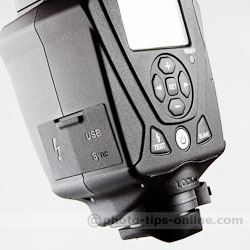 |
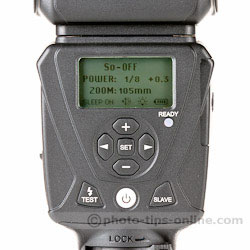 |
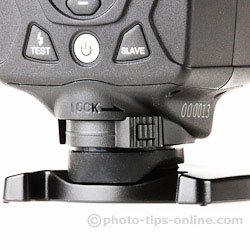 |
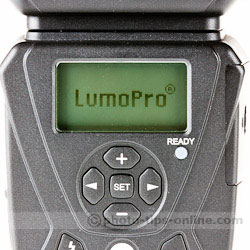 |
For many years, speedlights have not had battery level indicators, which was disappointing considering that batteries are a critical part of flash operation. In preparing for another job, it was impossible to tell whether your batteries were going to last for the entire session or if they were going to let you down right at the beginning. Luckily, these days, most of the new flash models are designed with this in mind, and LumoPro LP180 is not an exception. It has a 5-level indicator providing a pretty good picture about your battery state.
We were pleased to see that the flash head of LumoPro LP180 rotates full 360 degrees (180 degrees in both the left and right directions), which gives you maximum flexibility for bouncing the light off of walls and ceilings. Also, the head tilts from -7 degrees (for macro shots) to the full vertical position.
LP180 can zoom from 24 mm to 105 mm. With the built-in wide angle diffuser, the frame coverage can be extended to 14 mm. The built-in catchlight card provides you with some fill light when necessary.
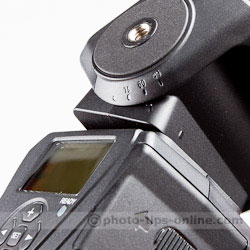 |
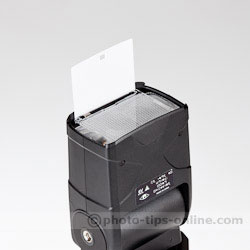 |
LumoPro LP180 is a quad-sync flash. There are 4 ways to trigger the unit: via hot-shoe, PC socket, miniphone port, or optically. Therefore, no matter what trigerring option you prefer, LP180 has got you covered.
For the optical triggering, LP180 has 11 different slave modes: S1, S2-1, S2-2, ..., and S2-10. S1 is for use with another manual flash or a studio strobe. S2 modes ignore pre-flashes, which makes it possible to trigger LP180 by various TTL systems. S2-1 and S2-2 are for the Canon and Nikon pop-up flashes, respectively. If your flash does not trigger LP180 in S2-1 or S2-2 modes, you can experiment with the rest of the modes (S2-3 through S2-10) to find the mode that is compartible with your master flash.
 |
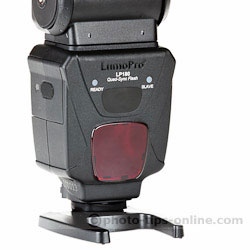 |
The slave LED's, indicating that the flash is ready to fire, are located on the front and on the back of the flash body, so at least one of them should be visible to you regardless of the flash position.
There are few more things to note about LumoPro LP180. Like many other modern flashes, it has a USB port to make future firmware updates simple. Small things, like spring loaded battery compartment door and metal mounting foot, are all consistent with the image of a top-notch flashgun.
The sound function, auto-backlight, and auto-sleep mode can be turned on and off depending on your preferences or shooting environment.
LumoPro LP180 is compatible with a standard ISO hot shoe, which is used by Canon, Nikon, Olympus, and Pentax cameras. Sony and Minolta campers will need a hot shoe adapter.
Please also note that while the hot shoe contacts are protected by the splash guard (the rubber around the mounting foot), the flash itself is not waterproof. However, based on how LP180 looks and feels, it should probably be able to withstand a good water splash. Obviously, we would not recommend using this flash in the rain. However, if you get caught off-guard by rainy or snowy weather, chances are LP180 should survive while you are putting it away.
 |
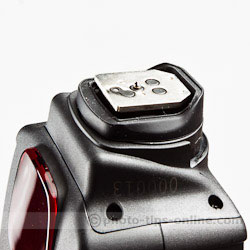 |
The LumoPro LP180 flash comes with a number of accessories. We have already mentioned two sets of color filters. It also comes with a miniphone sync cable and a flash stand. The stand has a 1/4-20 metal thread at the bottom, so it can be used as a hot-shoe adapter.
The included carrying pouch is even better that Canon 580EX II used to come with. It is noticeably thicker for more protection, and it features a belt loop and a small pocket on the back where you can put the color gels, for example.
 |
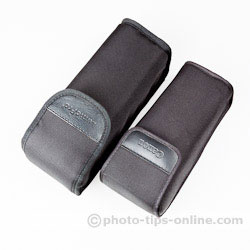 |
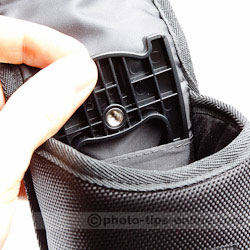 |
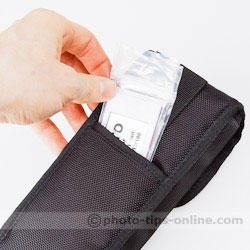 |
Compared to the previous LP160 model, LumoPro LP180 is a huge step forward. We are not going to get into too much detail here, but here are just a few improvements: finer power level adjustments, external power connector, better controls and mounting, more triggering modes, catchlight card, extended zoom range, USB port, included filters, light stand mount, etc. Also, LP180 restores its last settings when powered back on.
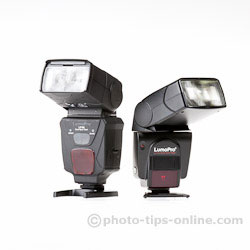 |
 |
While LP160 was a great reliable unit, the new LumoPro LP180 Quad-Sync Manual flash is simply superb. It is as powerful as the flagship units of the major brands. It is extremely easy to use. Comapby's great attention to details can be seen in all aspects of the design of the flash. The built-in gel holder (even though it's limited in its applications, in our opinion) and the built-in light stand mount make LP180 stand out from the crowd. If you don't need the fancy TTL features, LumoPro LP180 is arguably the best manual flash on the market today.